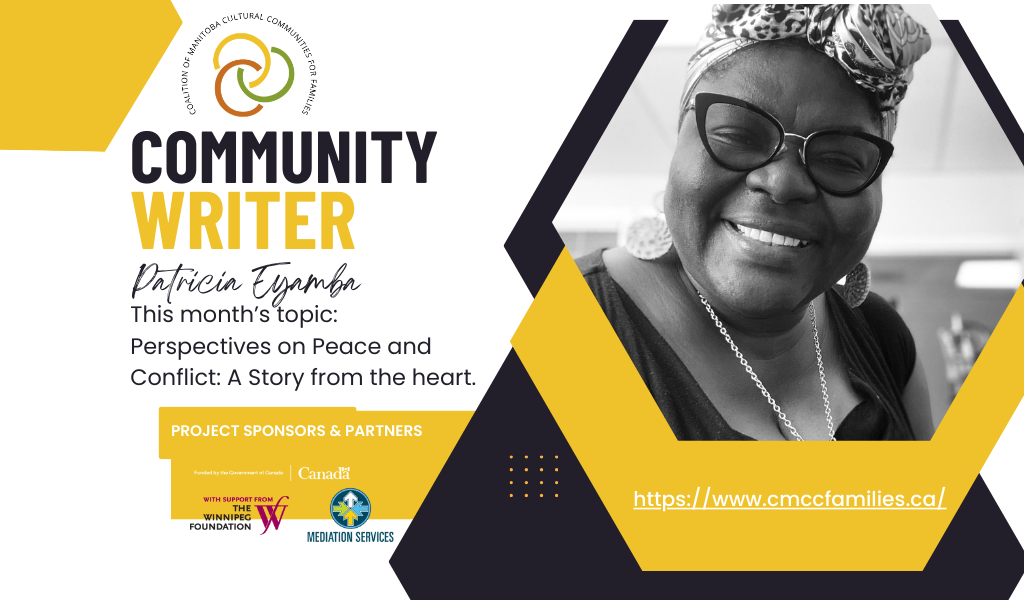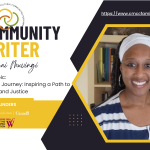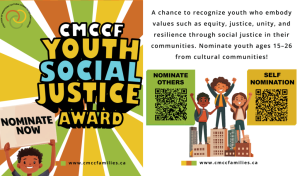
Perspectives on Peace and Conflict: A Story from the heart
We are living in a world often defined by wars and rumours of wars, stories of resilience and inner peace stand as powerful testaments to the human spirit. Today, I have the privilege of sitting down with Mr. Abia Galadima (real name withheld) a seventy-year-old man (he corrected me and said he is 70yrs young) This is Hilarious!
Mr. Galadima has lived through tremendous challenges—both in his homeland and as an immigrant in Canada. Though he chooses to remain anonymous, his experiences and insights are anything but hidden. After about 30 years in Winnipeg, Galadima has witnessed firsthand how peace, identity, and conflict can shape a person’s life in profound ways.
In this interview, Galadima shares his journey of navigating the complexities of being a Black Canadian, his reflections on belonging, and how he has crafted a personal sense of peace despite enduring both external and internal conflicts. From escaping a war-torn homeland to building a new life in Canada, his story offers a unique perspective on resilience, cultural identity, and the power of community. Through his candid reflections, we are invited to explore peace—not as a distant, abstract ideal—but as something we can cultivate within ourselves, no matter the circumstances.
It is a Sunday evening of September 15th, 2024. I walked into the home of Mr. Galadima located at East Transcona of city of Winnipeg. I pressed the doorbell and a calm voice answered, a lady opened the door and ushered me in. I stepped into a beautiful, adorned home with life plants, simple but sophisticatedly furnished. Are you Patricia! She asked. Yes please, I responded. My husband has been expecting you. Oh! you are Mrs Galadima? Yes, I am! She affirmed. Welcome, please sit down. Thank you, Ma! Thank you for having me. You are welcome, Patricia! He is coming to meet you soon. I re-echoed, thank you ma! You have a beautiful home! I complimented. Thank you, Patrica. This is our humble home. Do you care for water or tea? Oh, I’m good! Thank you.
As I was reaching out to sit down on this white leather couch, Mr. Galadima, announced his appearance by welcoming me.
Galadima: “Welcome, Patricia. Thank you for giving me the opportunity to add my voice to the ongoing conversations about peace and conflict.”
His voice echoed warmly as I settled into the couch.
Me: “Thank you, Mr. Galadima for taking the time to have this conversation. I truly appreciate your willingness to share your story.”
I settled into the couch feeling a sense of anticipation. Mr. Galadima looked at me with a small smile and asked, “Hmm, what was your question again?
I replied, we’re discussing your lived experiences with peace and conflict in your community.
Mr. Galadima: “Ah, perfect! Exactly what you want to hear, right?”
Me: “Yes, exactly!” I smiled.
Mr. Galadima: “Well, first, let me clarify what I consider my ‘community.’ Or do you have a specific definition in mind?”
Me: “Not at all! Whatever ‘community’ means to you is what matters. Why do you ask?”
Mr. Galadima “Because I don’t identify as a Black African; I see myself as a Black Canadian. Canada is my community—specifically, Winnipeg.”
Curious, I asked, “Why do you identify as a Black Canadian, and why don’t you focus much on Africa?”
Mr. Galadima: “I’ve been here for 30 years. This is home now. My wife is here, my children are married to white Canadians, and my life is rooted in this place. My skin is deceiving, you see. Are you still interested in this conversation?”
Me: I nodded eagerly. “Of course! As a Black African woman myself, I find this perspective fascinating.” Straight to conversation, he said:
Mr. Galadima: “For me, the first step toward peace was becoming Canadian on the inside, even though my skin is different. That’s when I first understood peace. Peace isn’t the absence of storms; it’s being in control of yourself, even when there’s conflict around you.” When I saw myself as white Canadian, I stopped complaining about almost everything as I usually do “
He paused for a moment, then continued: “At the simplest level, we face conflicts every day. Peace is a choice. When you’re deciding what to wear or eat, that’s a small conflict. You decide. The same applies when you have a conflict with a friend. Sometimes, you give in. Peace that depends on others is different from personal peace.”
He leaned forward, speaking more softly: “I’ve learned that peace is relative. What gives me peace may not give you peace. For me, peace came when I accepted that everyone is different—and that’s the beauty of creation. I don’t have to agree with everyone. I chose to celebrate those differences.”
He then shifted the conversation: “You may have expected me to talk about racism, bias, inequality… but if you focus on those things, you’ll never have peace. Yes, I’ve faced hate, bullying, and discrimination, but my response was to work harder and see myself as Canadian. That mindset shift changed everything for me. If I labelled myself an ‘African immigrant,’ it felt like I was excluding myself from the opportunities here.”
Mr. Galadima explained that this mental shift helped him avoid feeling pitied or boxed in by labels. He embraced his new reality, balancing the complexity of being Black while integrating into Canadian society.
Mr. Galadima “I refused to be pitied. I became Canadian, not just in citizenship but in mindset.”
He then shared his personal journey: “When war erupted in my homeland, my village was torn apart. Friends, family—everyone was affected. The decision to leave was hard but necessary. I packed my life into a suitcase and came to Canada with my family. Thinking Canada would be paradise, sadly, I faced a different kind of conflict which wasn’t violence, but the struggle of identity and belonging.”
“I struggled with language barrier. Learning a new language at 40 and adapting to a new culture were huge challenges. But the real conflict, was internal. The guilt of leaving my homeland behind haunted me daily.”
Mr. Galadima continued sharing, was becoming emotional.
Mr. Galadima “Could I have stayed and fought for peace in my country? These thoughts haunted me. But I found moments of peace in community centers, where other immigrants shared stories. I realized that peace wasn’t just the absence of war—it was found in connection, in shared experiences. Peace became something smaller and more personal, you know what, Patricia! One evening, as I sat quietly in my home, I had a profound realization: “Peace wasn’t external—it wasn’t about waiting for the storm to end or the world to fix itself. Peace was something I could create within myself, despite the pandemonium around me.”
According to him, through it all, he came to “understand that peace is not about the absence of conflict, but the courage to move forward in spite of it.”
Me: “This is a powerful perspective, Mr. Galadima I have so much to learn from you.”
Conclusion:
Mr. Galadima’s story is one of deep transformation. His journey from a war-torn homeland to a new life in Canada reflects not only the external conflicts he has faced but the internal battles he has conquered. Through his experiences, he’s shown that peace is not simply the absence of conflict but a daily commitment to rise above struggles and embrace the present.
What stands out for me is Mr. Galadima’s unwavering decision to forge his identity as a Canadian while honoring his past. His message is clear: peace begins within and is not dictated by circumstances or the labels society places on us. It is a deeply personal path shaped by resilience, self-acceptance, and the courage to see beyond divisions.
As Mr. Galadima continues his life in Winnipeg, surrounded by his children and grandchildren, his story serves as a testament to the power of personal peace and the strength it takes to live in harmony, despite the chaos that may surround us. Ultimately, peace, for Mr. Galadima is not about where you come from or the battles you’ve faced but about the choices you make every day to live with purpose, understanding, and hope.

This article was written by community writer Patricia Eyamba as part of our J.E.D.I. Initiative – Community Writers Project. All thoughts and opinions expressed are Patricia’s own.
To learn more about our Building Bridges Peace Project, please click: here

 Previous Post
Previous Post Next Post
Next Post
